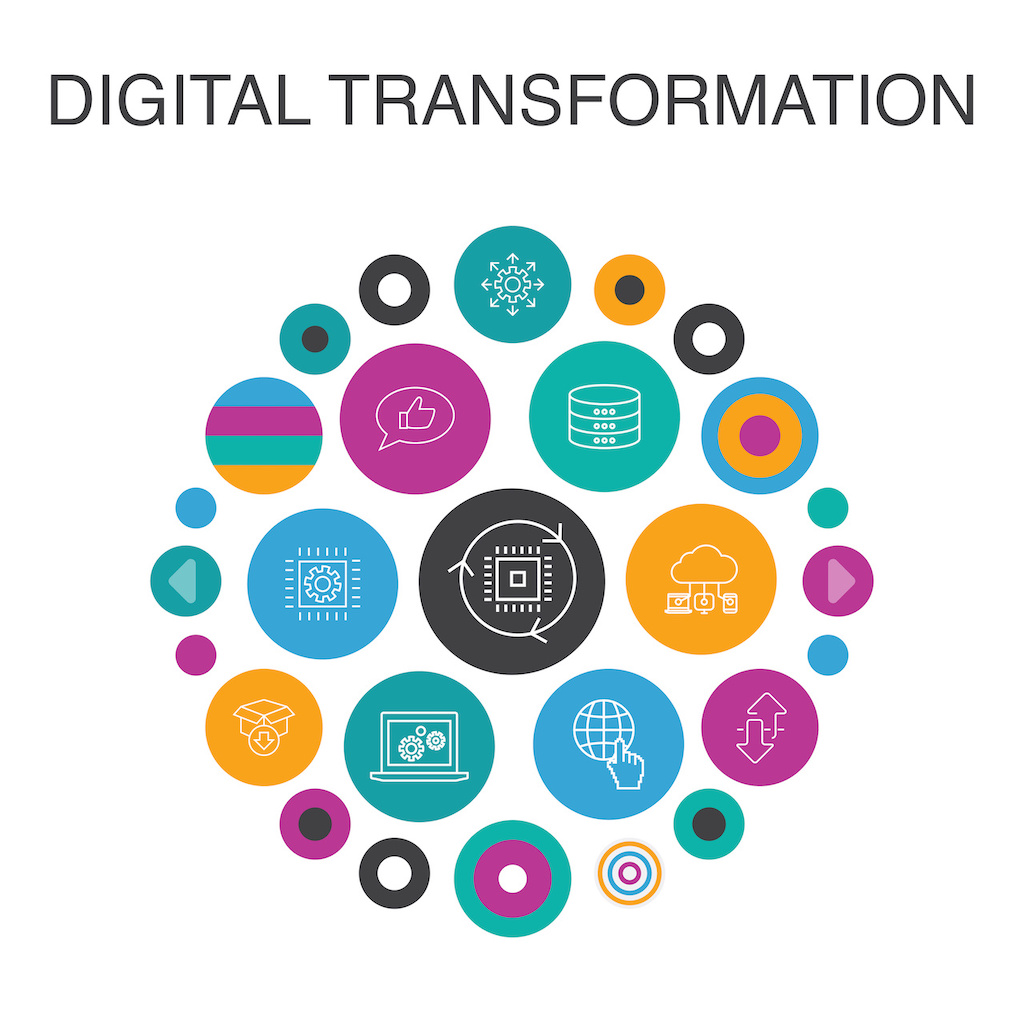What is Digital Transformation
Digital transformation is the integration of digital technology into every area of a business, permanently changing how an organisation run and provide value to customers. It’s necessary for every business and it also serves as a cultural change that asks organisations to always question the status quo, experiment, and be okay with failure.
The term “digital transformation” refers to the process of using digital technologies to create and/or modify existing business processes, culture, and customer experiences to meet changing business and market requirements. This means that all previously known roles such as sales, marketing, and customer service must surpass such changes. In short, face the innovation and innovate or go extinct.
Digital transformation can be a daunting task for any organisation, large or small. But with the right strategy and collaboration among key stakeholders, it can be a successful undertaking.
In this article, we’ll explore the keys to a successful digital transformation, including a thought-out strategy and cross-functional collaboration.

Source: https://bit.ly/3v7SMiD
Digital Transformation - Strategies and Essentials
The digital transformation strategy of an organisation can be different based on various factors such as business size, maturity, target market, industry, and other conditions that may support the success of the business.
Digital transformation is not something that can be done overnight and it requires continuous effort as well as the adoption of technology and its advancements to support the long-term business success.
Advanced technology can help unlock important customer insights. In order to create products that are more customer-centric, it is important to first understand your target market and what they want or need. The most important factor in doing this is to define digital transformation within your company so that your employees know what is expected of them.
First and foremost, focus on what’s important. Developing a digital transformation strategy necessitates a major change in thinking for both your organisation’s executives and employees.
Your strategy should encompass the entire company, and it needs to be tangible, pulling together the corporate strategy, product strategy, technology strategy, and digital strategy into a single roadmap. This roadmap will serve as a clear guidepost for your digital transformation journey.
There are a few key things you need to take into account when designing your digital transformation strategy:
Business transformation
There are three main types of business transformation: process, domain, and model.
- Process transformation - involves shifting your business processes to integrate new technology with the aim of increased efficiency, lower costs, and improved quality.
- Domain transformation - means you may need to re-evaluate how organisation’s value is delivered to your customers and opening up to new opportunities for growth.
- Model transformation is the final type, which means changing the way your business operates to better adapt to new market conditions or customer needs. When it comes to product creation or service development, your organisation needs to be able to adopt new technologies as they come out. Additionally, it’s important to take advantage of your company’s success in one area to help facilitate a larger expansion.
- Cultural and organisational transformation - Business leaders must encourage employees to work collaboratively and foster a culture that understands, embraces, and drives digital transformation.
Digital Transformation Journey
In order to successfully navigate the digital transformation journey, it is important to be aware that the path may change often and to have a flexible strategy accordingly.
Many factors will influence the best course of action for your organisation, such as the leadership’s commitment to change and invest, your competitive landscape, how far your organisation is willing to take risks, and your core capabilities for delivery.
Most importantly, always keep the desired outcomes of the digital transformation in mind so as not to lose sight of what you’re trying to achieve.

Source: https://bit.ly/3jp4enm
What the Data Tells Us About Digital Transformation [by Industry]
Data is integral part of any organisations’ digital transformation in the last few years. Newer technologies are becoming commonplace and easily accessible for businesses and customers alike.
Data digital transformation specifically is the process of digitally enabling and enhancing a business to better understand, align, and act on both online and offline data to create value. A digital transformation that relies on data will work to unify and refine the right tools, data strategy, data management, process and analytics to enable accurate data insights.
This, in turn, will help align and refine online and offline data to support intelligently informed decision-making across a business.
No two organisations are the same, so it only makes sense that their digital transformations would be unique as well. The goals, priorities and ambitions will all be different, as each organisation has different starting points and technologies in place.
At its core, a digital transformation uses technology and data to create insights and data points that will measurably improve the customer experience. The goal is to increase sales, loyalty and brand advocacy.
It’s important for any organisation to be able to identify areas of improvement in order to work smarter and more efficiently. This software will help you do just that by highlighting areas where you can save time and money, and reducing waste overall. In other words, it has the potential to lower the cost of doing business—which is a major bonus!
The following metrics are important to track, as they will provide valuable insights:
- Return on Digital Investments
- Employee Productivity
- Adoption & Performance Metrics
- Customer Experience Metrics
- Percentage of AI-Enabled Businesses
- Reliability & Availability
- Cost-Benefit Analysis
- Revenue from Digital Technology
- Percentage of Cloud Deployments
- Active Usage Metrics

Source: https://unsplash.com/photos/21mJd5NUGZU
How to Speed Up Your Digital Transformation
With technology advancing at such a rapid pace, digital transformation has become an inevitable trend for any existing business to catch up with. Although much progress has been made in this area—from hardware and infrastructure to revised work procedures and an optimised corporate culture—many businesses are still struggling with how to apply digitalisation initiatives in a sustainable manner.
For any business to be successful in today’s market, they need to accelerate their digital transformation.
Businesses that are able to speed up their digital transformation process often have an advantage over their competitors. Their procedures become more efficient and user-friendly, which can save the business money in the long run.
The fundamental reason that digital transformation must be accelerated is because a business needs to keep up with the changing times. If they don’t, they’ll struggle to stay relevant in their industry, and new businesses as well as competitors who are willing to adapt will take their place in the market.
Businesses that can provide digital services quickly and efficiently often see a massive growth in popularity and profit in a relatively short period of time.
Here are the five areas you need to focus on to speed up digital transformation:
1. Develop a clear vision and strategy for your digital transformation.
2. Set up an effective governance framework.
3. Create a culture of innovation and continuous improvement.
4. Invest in the right technologies and capabilities.
5. Focus on delivering value to customers and employees.

Source: https://unsplash.com/photos/oyXis2kALVg
Digital Transformation – Best Case/Proof in 2023
Amazon
Extended the B2C model to embrace B2B transactions with a vision to improve the customer experience.
Overview:
Amazon Business is a fantastic example of how a huge consumer-based company like Amazon can make the shift to being a B2B (business to business) type of organisation in order to keep up with the demands and expectations of digital customers. Not only does it provide a marketplace for businesses to purchase from Amazon, but there are also third-party options available. And not only that, but individuals can also make purchases on behalf of their organisations - making things like order approval workflows and reporting much easier to manage and deal with.
Approach:
By offering over 250 million products ranging from cleaning supplies to industrial equipment, Amazon created a one-stop shop marketplace for B2B vendors.
It introduced free two-day shipping on orders worth $49 or more and exclusive price discounts. Further, it offered purchase system integration, tax-exemption on purchases from select qualified customers, shared payment methods, order approval workflows, and enhanced order reporting.
Amazon allowed manufacturers to connect with buyers and answer questions about products in a live expert program. This gave manufacturers the ability to build trust with potential customers and create a more positive customer experience.
Value:
Amazon could tap into the B2B wholesale market, which is valued between $7.2 and $8.2 trillion in the United States alone.
The company could earn revenue by charging sales commissions ranging from 6-15% from third-party sellers, depending on the product category and the order size.
Amazon could also offer more personalised products for an improved customer experience.
Netflix
Transformed the entertainment industry by offering on-demand subscription-based video services to its customers.
Overview:
When Netflix first started out, their business model was very similar to that of Blockbuster’s. They had a pay-per-rental system that included both DVD sales and rent-by-mail services. However, Netflix was able to see that customer demand was changing with the rise of digitalisation and they adapted by providing online entertainment. This move wiped out Blockbuster and the entire movie rental industry.
Approach:
In 2007, Netflix launched a video-on-demand streaming service to complement their DVD rental service. It implemented a simple and scalable business model, investing 10% of its budget in R&D every year. The company has an unparalleled recommendation engine that provides a personalised and relevant customer experience.
Value:
Netflix is the most popular digital video content provider, leading other streaming giants such as Amazon, Hulu, and Youtube with over 85% market share. Its subscriber base increased by a record 36 million after the start of the COVID-19 pandemic.
Tesla
Uses connected car technology and over-the-air software updates to enhance customer experience, enable cost savings, and reduce carbon emissions.
Overview:
Any discussion about digital transformation must give credit to Elon Musk and the unconventional ideas he’s implemented, most notably with Tesla. The very existence of Tesla is a huge manifestation of digital transformation, as the company’s core motive was to prove that electric cars are not only better than their gasoline counterparts in looks, but in performance as well. Over the years, Tesla has worked hard to improve its product, become more economical, and reduce its carbon footprint.
Approach:
Tesla is the only auto manufacturer that provides automatic, over-the-air firmware updates for its cars. This allows Tesla cars to remotely improve their safety, performance, and infotainment capabilities. For example, the OTA update could fix Tesla’s overheating issues due to power fluctuation.
Tesla recently launched an autopilot feature for their cars that helps to control the speed and position of the car automatically when it’s on highways. Even though the user still has to hold the wheel, the car will take care of everything else by itself. This new connected car technology has allowed Tesla to create an intelligent data platform as well as a smart autonomous driving experience for their customers.
Tesla is at the forefront of data-driven innovation, using analytics to glean actionable insights from demand trends and customer complaints. It’s noteworthy that the company has been collecting driving data from all of its first- and second-generation vehicles. So far, Tesla has collected driving data on 8 billion miles, while Google’s autonomous car project, Waymo, has accumulated data on 10 million miles.
Value:
Tesla’s over-the-air updates not only reduce carbon emissions by saving users’ dealer visits but they also save consumers time and money. It delivered a record of 936,172 vehicles in 2021, which is an 87% increase from the 499,550 vehicle deliveries made in 2020.
Conclusion
The term “digital transformation” can be quite broad, but in general, it refers to how a company changes its operations and customer interactions to work in a digital world. This usually includes changes to internal tools and employee interactions, as well as how the company’s technical infrastructure supports these new digital processes. Although it may sound expensive, digital transformation can actually help reduce operational costs if done correctly. For example, by automating certain tasks or processes, companies can save on labour costs. Additionally, digital transformation can help improve customer satisfaction and loyalty, leading to increased revenue.
For the past few years, digital transformation has been an ever-changing landscape, with businesses using single-feature tools and outdated enterprise systems. However, as the market continues to evolve and become more complex, there will be a demand for holistic business management solutions that are not only robust, but also easily customisable and agile.
An organisation can only stay competitive by investing in two things: the technological knowledge of their employees, as well as implementing modern technological solutions. The benefits of doing so are plenty, ranging from an increase in efficiency and productivity, to a decrease in costs. Additionally, it leaves more room for an organisation to focus on growth.
Contact us to assist you with Digital Transformation strategies.










